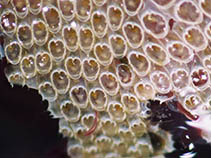Electra pilosa (Linnaeus, 1768)
Hairy sea-mat
Classification / Names Common names | Synonyms | CoL | ITIS | WoRMS
Gymnolaemata | Cheilostomatida | Electridae
Environment: milieu / climate zone / depth range / distribution range Ecology
Sessile; depth range 0 - 140 m (Ref. 125206). Temperate; 78°N - 51°S, 113°E - 41°E
Distribution Countries | FAO areas | Ecosystems | Occurrences | Introductions
Indo-Pacific, Northern Atlantic and the Mediterranean Sea: from Western Australia to USA, northeast to Svalbard and White Sea. Temperate and subtropical.
Length at first maturity / Size / Weight / Age
Maturity: Lm ? range ? - ? cm
Life cycle and mating behavior Maturity | Reproduction | Spawning | Eggs | Fecundity | Larvae
Main reference
References | Coordinator | Collaborators
Kühne, S. and E. Rachor 1996 The macrofauna of a stony sand area in the German Bight (North Sea). Helgoländer Meeresunters 50:433-452. (Ref. 2707)
IUCN Red List Status
(Ref. 130435: Version 2025-1)
CITES status (Ref. 108899)
CMS (Ref. 116361)
Threat to humans
Human uses
| FishSource |
Tools
More information
Diet composition
Food consumption
Predators
Max. ages / sizes
Length-weight rel.
Length-length rel.
Length-frequencies
Mass conversion
Abundance
Internet sources
BHL | BOLD Systems | CISTI | DiscoverLife | FAO(Publication : search) | Fishipedia | GenBank (genome, nucleotide) | GloBI | Gomexsi | Google Books | Google Scholar | Google | PubMed | Tree of Life | Wikipedia (Go, Search) | Zoological Record



